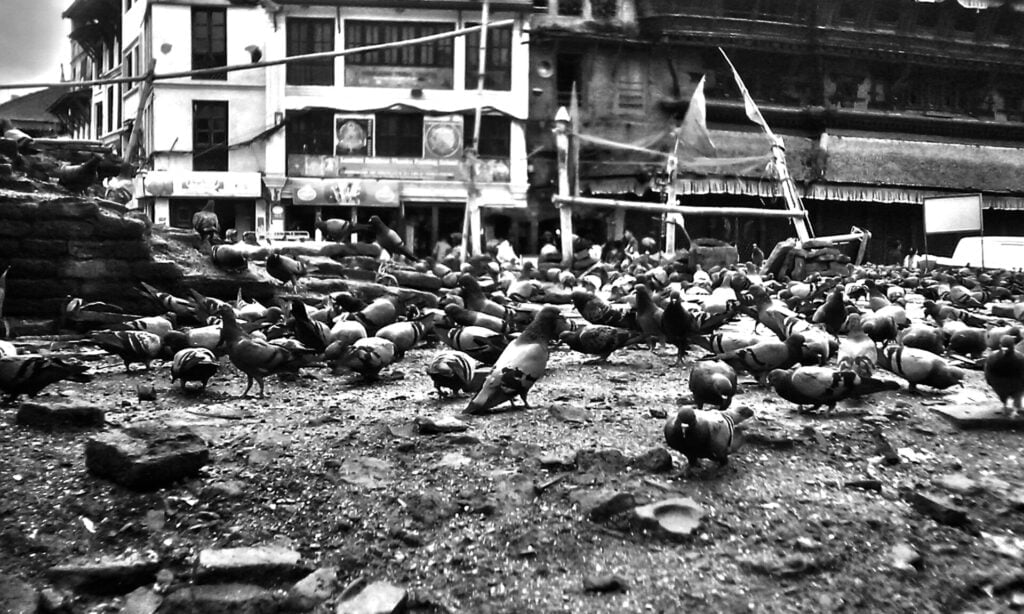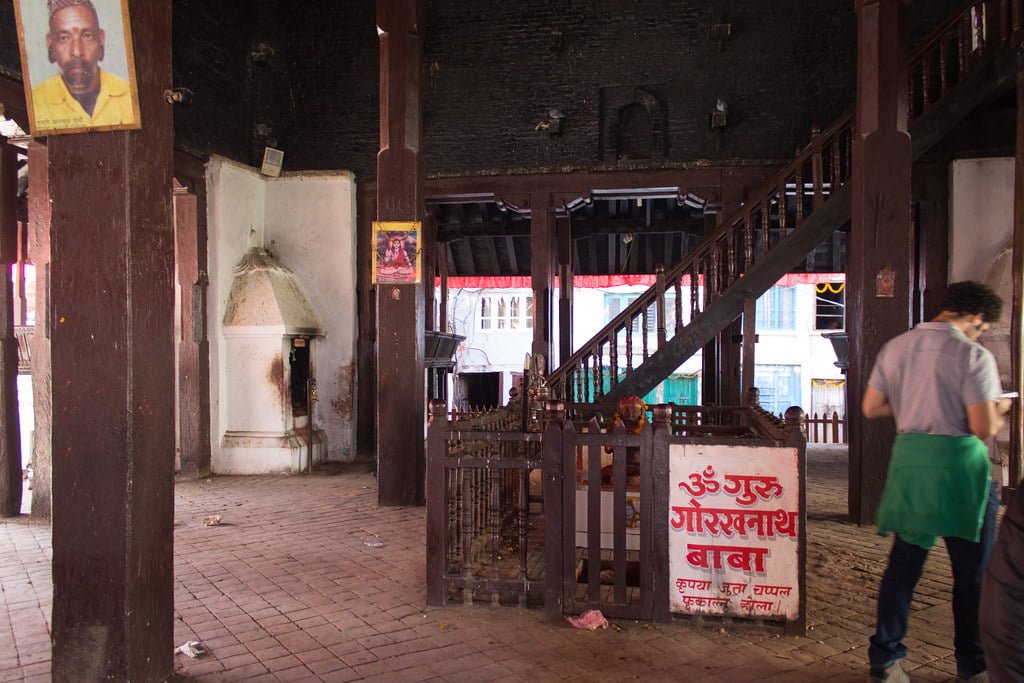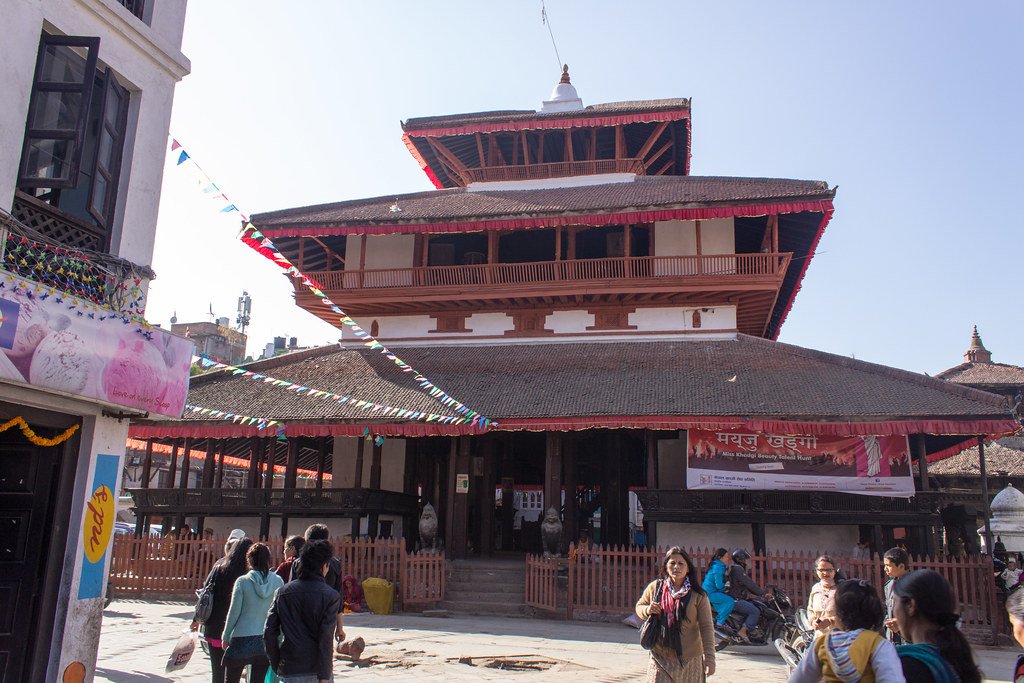History of Kasthamandap: From Collapse to Temple’s Reconstruction Journey
The Kasthamandap Temple, located in the heart of Kathmandu city, is a significant cultural and historical monument in Nepal. With a rich history and a blend of mythical legends, this temple holds a special place in the hearts of the Nepalese people.
Believed to have been constructed in the 12th century, Kasthamandap is a three-story pagoda-style temple that stands as a testament to the glorious past of the region. The name “Kasthamandap” itself holds significance, as it means “wood-pavilion” in the local language. This name is derived from the fact that the temple was built entirely from the wood of a single sal tree.
Originally, Kasthamandap, located at the Kathmandu Durbar Square, served as a community center and a rest house. It provided a gathering place for traders and became a popular spot for people to come together, share stories, and unwind. Over time, it transformed into an important pilgrimage site, attracting visitors from far and wide.
Who Built Kasthamandap?
Kasthamandap, a three-storied public shelter and shrine in Kathmandu, Nepal, was built in the early 16th century by King Laxmi Narsingha Malla. The temple is enshrined with the deity of Goraknath, a form of the god Shiva. According to local traditions, Kasthamandap Temple was constructed using wood from the Kalpavriksha tree. This mythical tree was believed to possess the power to regenerate itself, no matter how many times it was cut down. It is said that the temple was carved out of this sacred tree, symbolizing its eternal nature and the resilience of the Nepalese people.
The temple is also associated with the deity Goraknath, a form of the god Shiva. Goraknath, also known as the Lord who protects cows, is enshrined within the temple and is represented by footprints. This unique representation adds to the mystical aura surrounding Kasthamandap.
What Does Kasthamandap Mean in Nepali?
The word “Kasthamandap” holds significant meaning in the Nepali language. In its local vernacular, “Kasthamandap” directly translates to “a pavilion made from wood.” This name perfectly encapsulates the essence and historical significance of this architectural marvel.
The origins of Kasthamandap date back to the 12th century when it was constructed by a magnificent builder. What makes this structure truly remarkable is the fact that it was crafted from a single sal tree. Yes, you read it right, the entire shelter was created using only one tree! This speaks volumes about the craftsmanship and ingenuity of the builder.

History of Kasthamandap Temple
Kasthamandap is believed to be the oldest public building in the valley. Built in the traditional Newārī architecture style, it features a tiered-roof structure and is considered a symbol of the rich heritage of the region.
The construction of the temple, on Kathmandu Durbar Square, is rooted in local folklore and traditions, with one popular legend stating that the temple was built using the wood of a single sal tree. The name “Kasthamandap” itself is a nod to this mythical origin, highlighting the temple’s unique construction materials and techniques. According to local beliefs, the wood used to build the temple was obtained from the Kalpavriksha tree, a revered tree in Hindu mythology known for its regenerative powers, symbolizing eternity and resilience. This mythological connection infuses the temple with a sense of mystique and spirituality that continues to captivate visitors and historians alike.
The temple is also closely associated with the deity Goraknath, a form of the god Shiva. The representation of Goraknath within the temple, in the form of footprints, adds a spiritual dimension to the temple and has made it a site of pilgrimage and worship for devotees.
One particularly intriguing tale surrounding the construction of Kasthamandap Temple involves a tantric—a practitioner of esoteric rituals—who made a deal with the king to obtain the necessary materials to build a wooden temple. It is said that a giant Sal tree, which grew in the king’s land, was utilized by the tantric to construct the iconic temple. This historical account intertwines mythology, spirituality, and architectural prowess, further enhancing the temple’s historical significance.

Devastating Earthquakes and Their Impact on Kasthamandap Temple
The Kasthamandap temple has a rich history and cultural significance dating back centuries. However, its existence was dramatically altered due to major earthquakes that struck the region.
On April 25, 2015, Nepal experienced a powerful earthquake with an estimated magnitude of 7.9. This earthquake, along with its aftershocks, caused immense damage to heritage structures throughout the Kathmandu valley, including the Kasthamandap temple. The temple, along with many other monuments in Kathmandu’s World Heritage Monument Zones, suffered severe damage, and several structures collapsed entirely.
The destruction of Kasthamandap temple was a significant loss for Nepal’s socio-cultural and religious heritage. This iconic building, believed to be one of the oldest in Nepal, held immense historical value. It was not only a rest house but also served as a shrine for Gorakhnath, with a central statue dedicated to him. The temple’s unique architecture, characterized by intricate wooden carvings and its design, showcased the artistry and craftsmanship of Nepali culture from the 12th century.
The impact of the earthquake on Kasthamandap temple was not just physical. The loss of this beloved cultural symbol had a profound impact on the local community and the nation as a whole. The temple held deep spiritual significance for many, and its destruction left a void in the religious and cultural fabric of Nepal.
However, in the face of adversity, efforts were made to rebuild Kasthamandap temple. Despite challenges arising from disagreements between the local municipality and the Department of Archaeology, reconstruction finally began three years after the major earthquakes earthquakes. This rebuilding process aimed to restore the temple to its former glory, preserving its historical and architectural significance for future generations.
The reconstruction of Kasthamandap temple serves as a testament to the resilience and determination of the Nepali people. It symbolizes the importance of protecting and safeguarding cultural heritage, even in the face of natural disasters. By restoring this iconic temple, Nepal aims to reclaim a part of its rich cultural legacy and ensure its preservation for years to come.

Architecture and Design
Pagoda-Style Roof
One of the most awe-inspiring aspects of the Kasthamandap Temple in Kathmandu is its pagoda-style roof. The temple, like many other buildings in Durbar Square, showcases the traditional architectural design that is often synonymous with religion in South and Southeast Asia. The pagoda-style architecture originated in India during the 3rd century and has since spread to countries like Nepal, Myanmar, Korea, and Japan.
The pagoda-style roof of Kasthamandap is a testament to the meticulous craftsmanship of the artisans who built it. Each of the three roof levels is meticulously layered with faded terracotta tiles, creating a stunning visual display. The intricate details and careful construction of the roof reflect the rich cultural heritage of Nepal in terms of building design.
As visitors gaze upon the sprawling pagoda roof-top, it transports them back in time, allowing them to imagine Kathmandu as it was over 400 years ago when the Kasthamandap complex was first constructed. While many structures in Kathmandu have adopted more Western and concrete styles, Kasthamandap stands as a preserved example of Nepal’s architectural heritage.
Wood Carvings
One cannot speak of the architectural beauty of Kasthamandap without mentioning the exquisite wood carvings that adorn its structure. These intricate carvings are not only a testament to the craftsmanship of the Newar artisans but also a reflection of Nepal’s rich cultural heritage.
As visitors approach Kasthamandap, their eyes are immediately drawn to the grandiose, carved wood banister that surrounds the building. This meticulously crafted masterpiece showcases the immense skill and attention to detail of the 16th-century woodworkers. Each element of the banister, from the delicate motifs to the intricate patterns, tells a story of Nepal’s artistic legacy.
The wood carvings found along the building’s struts are of particular note. These masterpieces have withstood the test of time and have been recreated using both new and original wood. It is awe-inspiring to think that these wooden structures, devoid of any metal reinforcement, have remained intact for centuries. This speaks volumes about the exceptional construction techniques employed by the ancient artisans or perhaps even lends itself to the realm of legend.
To truly appreciate the artistry and cultural significance of these wood carvings, one must delve into the history of the Newar craftsmen. The Newar people have long been recognized as skilled artisans, renowned for their work in wood, metal, and stone. The tradition of handcrafted wood pieces has been passed down through generations, and its legacy can still be witnessed today in wood shops across the Kathmandu Valley.
Traditional Materials Used
In the reconstruction and preservation of heritage buildings, the use of traditional materials plays a crucial role in maintaining authenticity and ensuring structural integrity. Kasthamandap, a significant cultural landmark in Nepal, was no exception to this practice. The use of traditional materials in the reconstruction of Kasthamandap was not only essential for its historical significance but also for the preservation of its architectural integrity.
One of the primary traditional materials used in the reconstruction of Kasthamandap was seasoned timber. This type of timber, which is known for its strength and durability, was integral to the original construction of the building. The availability of seasoned timber posed a challenge during the reconstruction process, as it is not commercially produced. However, efforts were made to procure this material from limited sources to ensure that the reconstructed building closely resembled its original form.
Special bricks were another traditional material utilized in the reconstruction of Kasthamandap. These bricks, with their specific dimensions of 245x165x50 mm for big bricks and 220x15x50 mm for small bricks, were crucial in replicating the original architectural design. However, the limited production of these bricks and their soaring prices posed a significant obstacle. Despite these challenges, every effort was made to source these special bricks to maintain the authenticity of Kasthamandap.
The availability of stones, another essential traditional material, also posed a challenge during the reconstruction process. Stones are often in short supply for heritage reconstruction projects, and Kasthamandap was no exception. The limited stock of suitable stones required careful consideration to ensure that the reconstructed building maintained its original aesthetic and structural integrity.
The use of these traditional materials in the reconstruction of Kasthamandap was not merely a matter of historical preservation; it was also vital for ensuring the building’s structural safety. The traditional materials used in the original construction of Kasthamandap had proven their durability and strength over centuries. Therefore, the decision to utilize these materials in the reconstruction process was a rational choice to maintain the structural integrity and authenticity of this invaluable cultural heritage.

